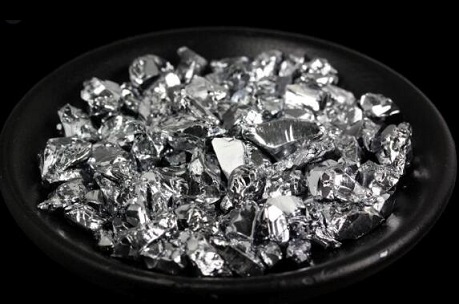Discovery and Application of Chromium
Discovery
On July 26, 1761, German geologist and mineralogist Johann Gottlob Lehmann (August 4, 1719 to January 22, 1767) found an orange-red mineral in the Beryozovskoye mines in the Ural Mountains that he called Siberian red lead (Lehmanni, 1766). However, it was misidentified as a lead compound with selenium and iron components.

Figure 1. Crocoite, PbCrO4, long, needle-like crystals up to 8 mm.
The mineral in question was actually crocoite (or lead(II) chromate) with the chemical formula PbCrO4. In 1770 Prussian zoologist and botanist Peter Simon Pallas (September 22, 1741 to September 8, 1811) visited the same locality as Lehmann and found a red lead mineral that was revealed to have useful properties as a pigment in paints. After Pallas, the use of Siberian red lead as a paint pigment rapidly advanced all over the region. In 1794 French pharmacist and chemist Louis Nicolas Vauquelin (May 16, 1763 to November 14, 1829) received some samples of this crocoite ore. He managed to create chromium trioxide (CrO3) by reacting crocoite with hydrochloric acid. In 1797 he subsequently found that he could isolate metallic chromium by heating the oxide in a charcoal oven (Vauquelin, 1798). Because of this, he is generally credited as the person who truly discovered the element chromium.
Vauquelin also managed to detect traces of chromium in precious gemstones, such as ruby (red variety of corundum) and emerald (green variety of beryl).
Application
Pigment and Tanning Salts
Chromium minerals as pigments became known in the west in the 18th century. Throughout the 19th century, chromium was mainly utilized not only as a pigment in paints but in tanning salts as well. For quite some time, the crocoite from Russia was the major source for such tanning salts. In 1827 a larger chromite ore deposit (Box 5.9) was found near Baltimore, United States, which rapidly met the demand for tanning salts much more effectively than the crocoite that had been used before. This made the United States the principal manufacturer of chromium products till 1848, when larger chromite ore deposits were discovered near the city of Bursa, Turkey.
Coating
Chromium metal is renowned for its reflective, metallic luster when polished. Weapons found in burial pits from the late 3rd century BCE Qin Dynasty containing the Terracotta Warriors near Xi'an, China, have been chemically tested by archeologists. While these weapons were probably buried more than 2000 years ago, the ancient bronze tips of both the swords and crossbow bolts found in the pits exhibited surprisingly little corrosion, perhaps because the bronze was purposely coated with a thin layer of chromium oxide. Nevertheless, this oxide layer on the weapons did not consist of pure chromium metal or chrome plating as it is normally produced today, but a very thin 10-15 μm layer of chromium oxide molecules with up to 2% chromium was observed, which was sufficient to protect the bronze from corroding.
Now, it is used as a protective and decorative coating on car parts, plumbing fixtures, furniture parts, and many other items, usually produced by electroplating. Chromium was utilized for electroplating as early as 1848, but this practice only became widespread with the development of an improved process in 1924.
You may like
Related articles And Qustion
See also
Lastest Price from Chromium manufacturers

US $10.00/KG2025-04-21
- CAS:
- 7440-47-3
- Min. Order:
- 100KG
- Purity:
- 99%
- Supply Ability:
- 100 mt

US $12.50-10.50/kg2025-01-16
- CAS:
- 7440-47-3
- Min. Order:
- 1000kg
- Purity:
- 99%
- Supply Ability:
- 1000ton/Year





